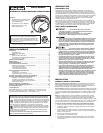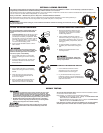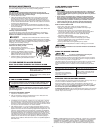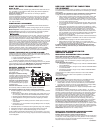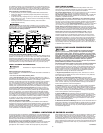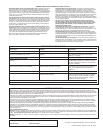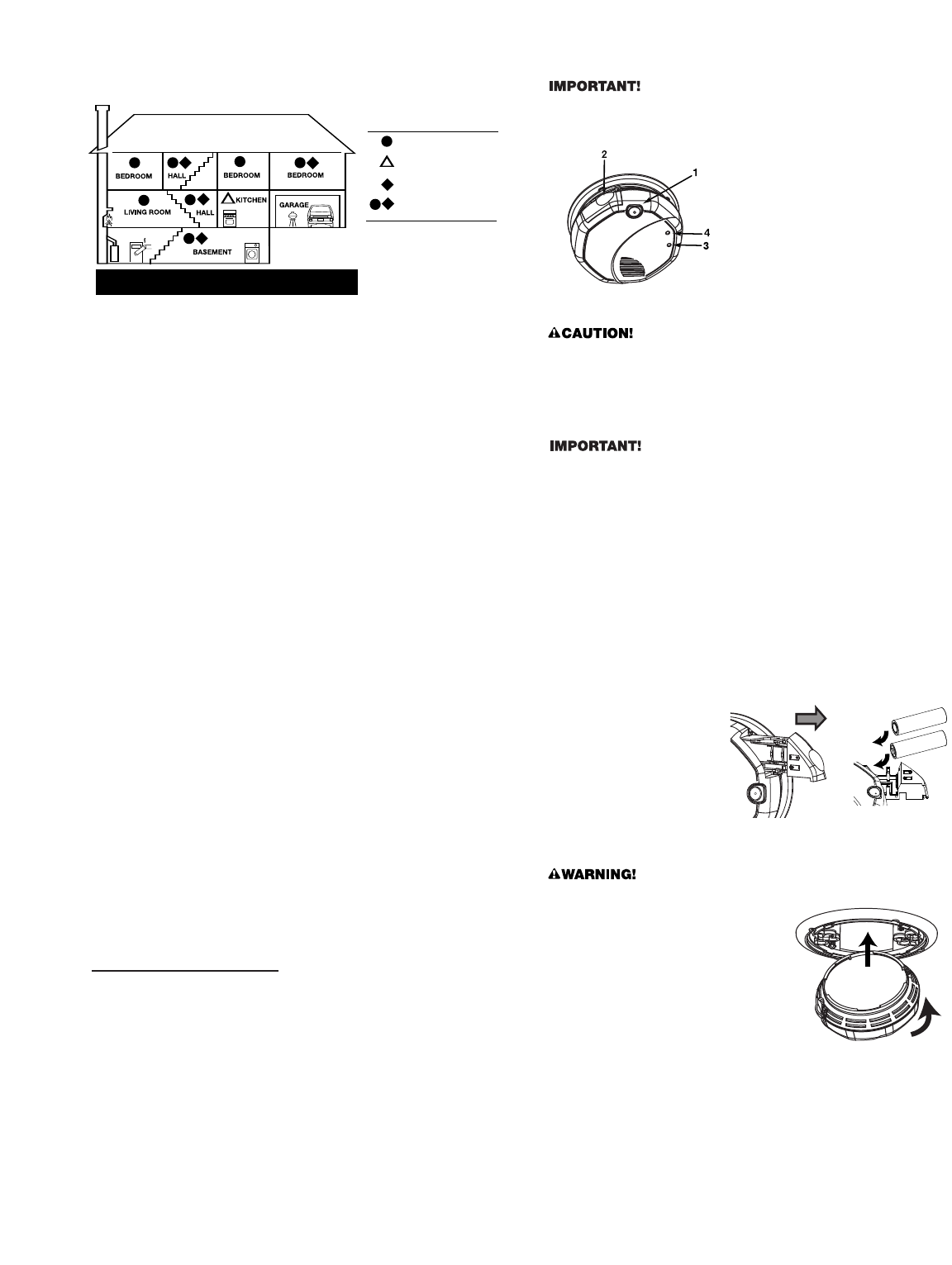
RECOMMENDED PLACEMENT
•
When installing on the wall, the top edge of Smoke Alarms should be
placed between 4 inches (102 mm) and 12 inches (305 mm) from the
wall/ceiling line.
•
When installing on the ceiling, place the alarm as close to the
center as possible.
•
In either case, install at least 4 inches (102 mm) from where the wall and
ceiling meet. See “Avoiding Dead Air Spaces” for more information.
NOTE: For any location, make sure no door or other obstruction could keep
carbon monoxide or smoke fr
om reaching the Alarm.
Installing Smoke/CO Alar
ms in Mobile Homes
For minimum security install one Smoke/CO Alarm as close to each sleeping
area as possible. For more security, put one unit in each room. Many older
mobile homes (especially those built befor
e 1978) have little or no insulation.
If your mobile home is not well insulated, or if you are unsure of the amount
of insulation, it is important to install units on inside walls only
.
WHERE THIS ALARM SHOULD NOT BE INSTALLED
Do NOT locate this Smoke/CO Alarm:
• In garages, furnace rooms, crawl spaces and unfinished attics. Avoid
extremely dusty, dirty or greasy areas.
• Where combustion particles are produced. Combustion particles form
when something burns. Areas to avoid include poorly ventilated kitchens,
garages, and furnace rooms. Keep units at least 20 feet (6 meters) from
the sources of combustion particles (stove, furnace, water heater, space
heater) if possible. In areas where a 20-foot (6 meter) distance is not
possible – in modular, mobile, or smaller homes, for example – it is
recommended the Smoke Alarm be placed as far from these fuel-burning
sources as possible. The placement recommendations are intended to
keep these Alarms at a reasonable distance from a fuel-burning source,
and thus reduce “unwanted” alarms. Unwanted alarms can occur if a
Smoke Alarm is placed directly next to a fuel-burning source. Ventilate
these areas as much as possible.
• Within 5 feet (1.5 meters) of any cooking appliance. In air streams near
kitchens. Air currents can draw cooking smoke into the smoke sensor
and cause unwanted alarms.
• In extremely humid areas. This Alarm should be at least 10 feet (3 meters)
from a shower, sauna, humidifier, vaporizer, dishwasher, laundry room,
utility room, or other source of high humidity.
• In direct sunlight.
• In turbulent air, like near ceiling fans or open windows. Blowing air may
pr
event CO or smoke fr
om r
eaching the sensors.
• In areas where temperature is colder than 40˚ F (4˚ C) or hotter than 100˚F
(38˚ C). These ar
eas include non-air
conditioned crawl spaces, unfinished
attics, uninsulated or poorly insulated ceilings, porches, and garages.
• In insect infested areas. Insects can clog the openings to the sensing
chamber.
• Less than 12 inches (305 mm) away from fluorescent lights. Electrical
“noise” can interfer
e with the sensor
.
•
In “dead air” spaces. See “A
voiding Dead Air Spaces”.
A
VOIDING DEAD AIR SP
ACES
“Dead air” spaces may pr
event smoke fr
om r
eaching the Smoke/CO Alarm.
T
o avoid dead air spaces, follow installation recommendations below.
On ceilings, install Smoke/CO Alarms as close to the center of the ceiling as
possible. If this is not possible, install the Smoke/CO Alarm at least 4 inches
(102 mm) from the wall or corner.
For wall mounting (if allowed by building codes), the top edge of Smoke/CO
Alarms should be placed between 4 inches (102 mm) and 12 inches (305 mm)
fr
om the wall/ceiling line, below typical “dead air” spaces.
On a peaked, gabled, or cathedral ceiling, install first Smoke/CO Alarm
within 3 feet (0.9 meters) of the peak of the ceiling, measured horizontally.
Additional Smoke/CO Alarms may be required depending on the length, angle,
etc. of the ceiling's slope. Refer to NFPA 72 for details on requirements for
sloped or peaked ceilings.
HOW TO INST
ALL THIS ALARM
This combination Smoke/CO Alarm was designed to be mounted on the
ceiling or wall. It is not a tabletop device.
You must install this device on the
ceiling or wall as outlined below
. Read “Where To Install This Alarm” before
starting.
T
ools you will need:
pencil, drill with 3/16” or 5mm drill bit,
flathead scr
ewdriver, hammer.
•
Do not connect this unit to any other alarm or auxiliary device. It is a
single-station unit that cannot be linked to other devices. Connecting
anything else to this unit may pr
event it from working properly.
•
Do not install this unit over an electrical junction box. Air currents
around junction boxes can prevent smoke from reaching the sens-
ing chamber and prevent the unit from alarming. Only AC powered
units ar
e intended for installation over junction boxes.
If you want to lock the batter
y compartment, or lock the Smoke/CO
Alarm to the mounting bracket, please read the “Optional Locking
Featur
es” section.
1. Hold base firmly and twist the mounting bracket counterclockwise (left) to
separate it from the unit.
2. Hold the mounting bracket against the ceiling (or wall) so the vertical
mounting slot is aligned in the 12 o’clock position and trace around the
inside of the mounting slots (vertical and horizontal mounting).
3. Put the unit where it won’t get covered with dust when you drill the
mounting holes.
4. Using a 3/16” (5 mm) drill bit, drill a hole through the center of the oval
outlines you traced.
5. Insert the plastic screw anchors (in the plastic bag with screws) into the
holes. Tap the screw anchors gently with a hammer, if necessary, until
they are flush with the ceiling or wall.
6. Line the mounting bracket up over the plastic screw anchors.
7. Screw the mounting bracket to the ceiling or wall through the mounting
slots using the two screws provided.
8. Before attaching the Alarm to
the bracket, insert the two (2)
AA batteries (included) into the
battery compartment. Match
the terminals on the end of the
battery with the terminals on
the unit. Match “+” to “+” and
“-” to “-.” If the batteries are
not fully inserted, the unit
cannot r
eceive battery power
.
NOTE: The unit may beep briefly when you install the batteries. This is normal.
The GREEN Light flashes about every 60 seconds when the unit is
receiving battery power.
The battery door will resist closing unless batteries are installed. This
war
ns you the unit will not operate without batteries.
9. Attach the Smoke/CO Alarm to the
mounting bracket. Line up the guides on
the alarm’s base with the guides on the
mounting bracket. When guides are lined
up, turn the base clockwise (right) until it
snaps into place.
NOTE: Once the Smoke/CO Alar
m is
snapped onto the mounting bracket,
you can rotate the Smoke/CO Alarm
to adjust the alignment.
10. Test the Smoke/CO Alarm. See “Weekly Testing” for details.
S
UGGESTED AREAS FOR INSTALLING
SMOKE ALARMS, CO ALARMS, AND COMBO UNITS
SMOKE ALARM WITH
SILENCE FEATURE
CO ALARMS
BOTH, OR COMBINATION
SMOKE/CO ALARMS
SMOKE ALARMS
KEY:
S
uggested locations are based on
NFPA recommendations (NFPA 72
for Smoke Alarms and NFPA 720 for
Carbon Monoxide Alarms). Always
refer to national and local codes
before beginning any installation.
In new construction AC and AC/DC smoke alarms MUST
be interconnected to meet NFPA recommendations.
PARTS OF THIS SMOKE/CO ALARM
1 Test/Silence Button
2
Battery Compartment
3
Power/Smoke Alarm LED
4
CO Alarm LED
2



